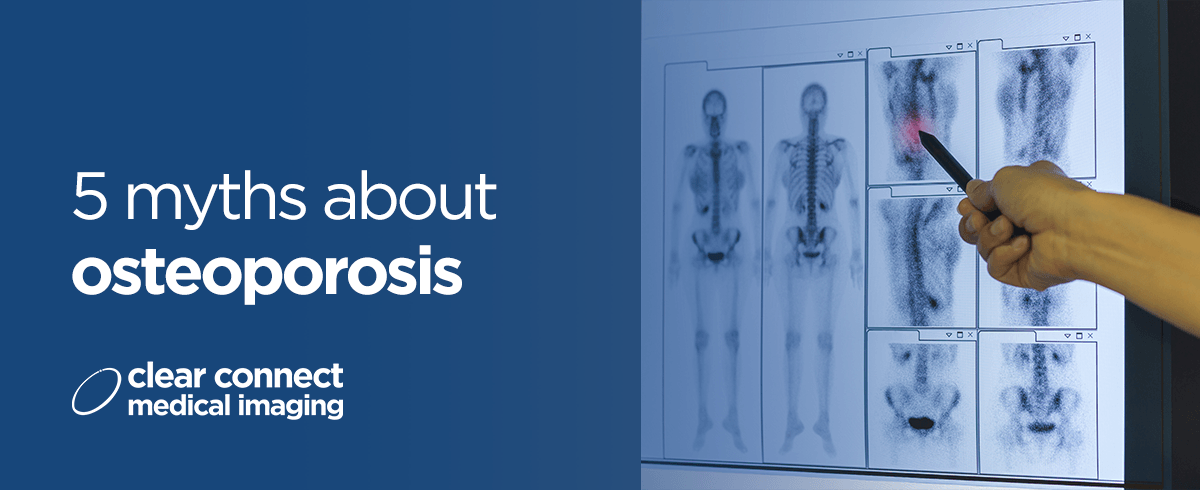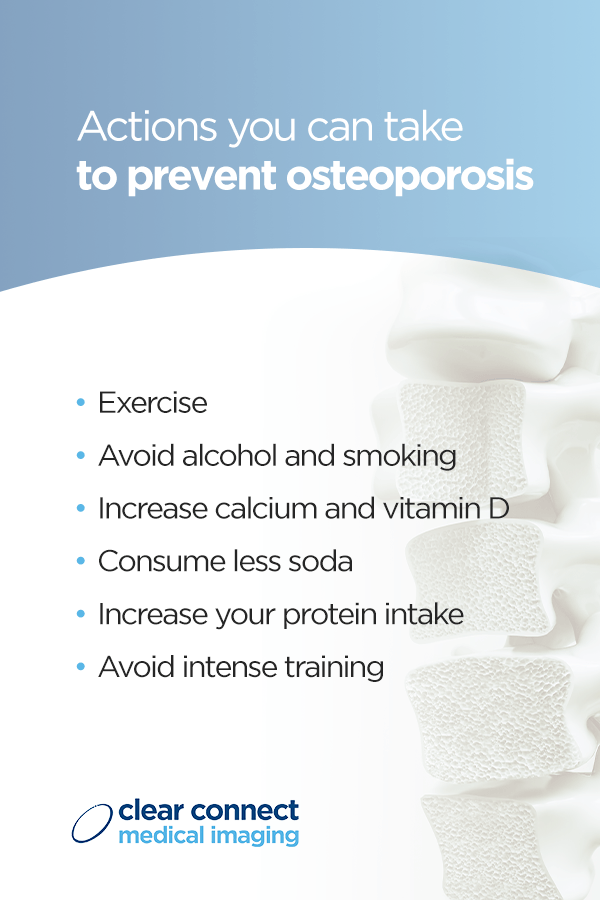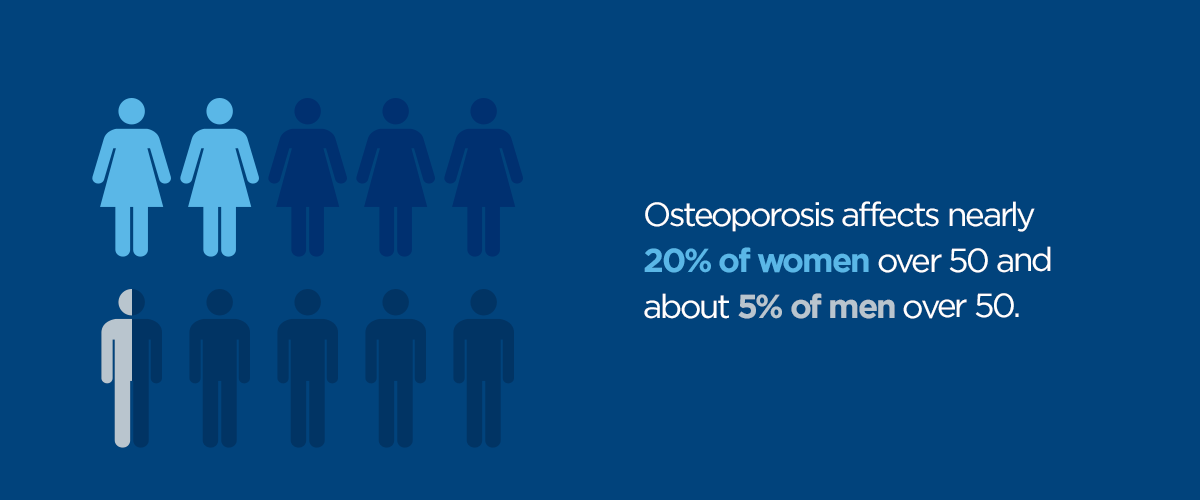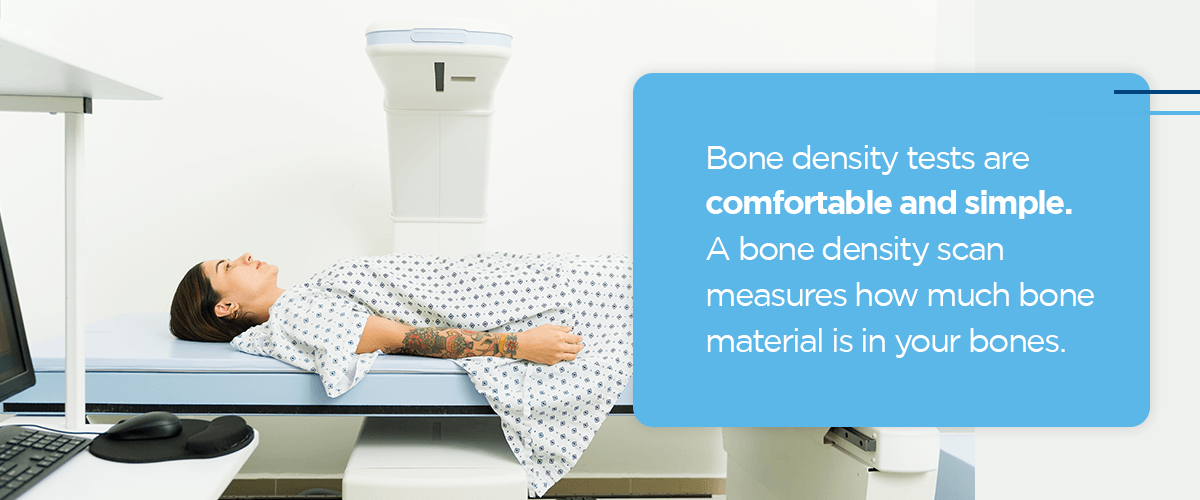
When new bone can’t keep up with the loss of old bone, osteoporosis occurs. Osteoporosis causes bones to weaken and become brittle. This condition can lead to bones breaking when they experience mild stresses like coughing or bending. Osteoporosis affects many people, and common breaks occur in the spine, wrist or hip. This condition affects many people of varying races and ages, but older women are often at the highest risk.
There are several misconceptions about this condition, which can lead to harmful consequences for some people. Thankfully, you can minimize your risk, and understanding what can increase your risk can help you reduce unhealthy habits. Learn more about osteoporosis, including some of the most common myths and how to prevent it.
Jump Ahead:
Common osteoporosis myths
Believing common myths about osteoporosis can lead to harmful habits and prevent you from taking the steps necessary to reduce your risk. There are several misconceptions about this condition regarding who’s at risk, the severity of the disease and whether you can prevent it. Look at these myths to understand the risks of this condition and how you can make changes to help your bones.
Myth #1: There is nothing you can do to prevent osteoporosis
One of the most harmful misconceptions about osteoporosis is that you can’t do anything to prevent it. There are several ways to keep your bones strong and healthy to minimize your risks. While several unchangeable factors affect your risks, you can do many daily things to build strong bones. Actions you can take to reduce your risk include:

- Exercise: Bones grow stronger when you provide a workout. Weight-bearing exercises are best for your bones because they force your body to work against gravity, prompting the body to make new bone. Exercises such as climbing stairs, walking, aerobics, dancing, jogging, tennis, water aerobics and yoga are excellent choices. You can also implement strength training into your exercise routine. Lifting young children, using resistance bands and free weights, doing squats or pushups, using weight machines and wearing wrist or ankle weights are excellent exercises. Exercise three to four times a week for the best results.
- Avoid alcohol and smoking: Habits like excessive drinking and smoking can affect your risks of osteoporosis. Excessive drinking means two or more alcoholic drinks per day. Drinking is linked to higher risks of bone loss, and smoking can double your chances of developing this condition. Smoking can lead to fractures because it prevents estrogen from working well, making you more likely to experience problems later.
- Increase calcium and vitamin D: Calcium aids in creating strong bones, and a lack of calcium can lead to bone mass loss. Be sure to get this nutrient from supplements or your diet. Salmon, sardines, dark green vegetables, fat-free or low-fat dairy products, and calcium-fortified foods and juices are excellent sources of calcium. Additionally, vitamin D enables your body to absorb calcium. Getting outside can increase your vitamin D intake, but you may need supplements depending on your age and lifestyle to meet daily needs. Foods with vitamin D include cheese, egg yolks, orange juice, tuna and cereal.
- Consume less soda: Some findings show that sodas can lead to bone loss. The extra phosphorus in these drinks may prevent the body from absorbing calcium. However, people could be replacing calcium-rich beverages with soda, leading to lower calcium levels.
- Increase your protein intake: Protein is essential for every part of your body. Eating protein can increase bone mineral density, making consuming the necessary daily amount essential. It’s recommended to intake 0.4 grams per pound of your body weight.
- Avoid intense training: Some women experience a triad of issues when they train and exercise intensely. These women can have thin bones, eating disorders and a lack of a menstrual cycle. Restrictive diets can also impact estrogen levels, leading to lower bone mass.
Myth #2: Most people do not need to worry about osteoporosis
Osteoporosis can affect people of every age, race and gender. It can be challenging to recognize when bones are weakening until there is a fracture or break, which may lead to unintentional neglect of the condition. People can begin losing bone mass as early as 30, and 43 million people have low bone mass, a precursor condition to osteoporosis.
Between age 25 and 50, bone density often remains stable with equal parts breakdown and formation. After age 50, bone loss accelerates, and bone formation can’t keep up. This change can happen slowly, making it difficult to detect when osteoporosis is taking hold. This condition affects nearly 20% of women over 50 and about 5% of men over 50. However, juvenile osteoporosis can affect some people’s growth and development from a young age.
The risk for osteoporosis can increase for women after menopause because estrogen levels fall. Women who experience menopause before age 45, have a hysterectomy before age 45 or have absent periods for more than six months are at an increased risk for osteoporosis. Treatments for breast cancer that decrease estrogen levels can accelerate bone loss.

There is a link between male testosterone and osteoporosis. This hormone keeps bones healthy, and the risk for this condition increases in men with low testosterone levels. Alcohol misuse, hypogonadism and some medications, like steroid tablets, are known causes of osteoporosis in men. Treatments for prostate cancer that reduce testosterone levels can also increase bone loss.
Additionally, this condition can affect people of all races, but some ethnic groups have a higher risk than others. For example, Chinese people have lower average bone mineral densities than other groups, but African Americans have a smaller risk of breaking a bone than other ethnic groups. Latina women have the highest risk of fractures compared to African Americans, Native Americans and Asian Americans, according to one study.
Genetic factors can also affect whether some groups need more nutrients than others. For example, African Americans may require less vitamin D and calcium to maintain bone health than other groups.
You can also discover whether you have osteoporosis by screening for it. People older than 65 should screen for osteoporosis, but those with certain risk factors, such as having a parent with a broken hip, should screen earlier in life. You should also schedule routine screenings every few years to monitor progress. Detecting this condition as early as possible can ensure you find the medication or lifestyle changes that can decrease your risks or strengthen your bones before worsening the condition.
Myth #3: Broken bones are the only danger
Osteoporosis can cause various problems. The most common symptom of this condition is breaking a bone from a minor accident, but there are several other dangers. Although some signs may seem less direct, they can still cause many issues. For instance, a symptom can be changes in your natural posture., such as bending forward more or stooping. You may also notice lower back pain, a loss of an inch of height or more, or a shortness of breath. Although these symptoms may seem minute, they can cause daily discomfort.
Furthermore, broken bones can have a significant impact on your life. Depending on the severity of the fracture, people can experience digestive discomfort, stomach pain or difficulty breathing. However, broken bones can also lead to temporary or permanent disability. Broken bones in the spine can weaken to the point of collapsing, causing significant pain.
After a hip fracture, people may need surgery. A hip break can be detrimental for some people and lead to a loss of independence. Some individuals may need assistance from health care professionals, friends or family to complete routine tasks such as bathing, dressing and shopping after surgery. Additionally, complications from this surgery can be severe and, in some cases, result in the individual needing long-term facility care from skilled nursing professionals. These fractures can also increase the risk of death within the first 12 months after the injury.
Osteoporosis can cause significant life changes and be challenging to navigate. Along with nursing a broken or fractured bone, several tasks may be difficult or impossible. Additionally, some people may not completely recover from these problems, leading to abrupt changes at home, throughout the rest of life and in relationships.
Myth #4: An osteoporosis test is painful
Bone density tests are comfortable and simple. A bone density scan measures how much bone material is in your bones. These scans use a very low dose of radiation and X-ray technology to measure the bone minerals and calcium packed into a bone’s segment. Often, the test is done on the forearm, hip or spine.

This scan often only takes between 10 and 30 minutes, and you will usually have bones tested that are more prone to breakage. During the exam, you lie on a padded table, and the machine slowly passes over you. An image is generated on a monitor, allowing your provider to obtain a clear picture of your bones.
A provider may recommend a bone density scan if you have risk factors like:
- Fragile bones
- Reduced height
- Lowered sex hormone levels
- Intake of anti-rejection medication
- Consumption of some medications that can affect the bone-rebuilding process
This scan can reveal numerous insights. Your provider can use a bone density scan to evaluate if your bone density has decreased, monitor osteoporosis progression, review treatment effectiveness, confirm your diagnosis or determine whether you are at high risk for breaking or fracturing your bones.
Myth #5: Osteoporosis is not serious
Osteoporosis is known as the “silent” disease, but it can be incredibly serious. Broken bones can be painful and affect emotional, physical and mental health. In some severe cases, death can occur. This condition has four stages, and the later stages can be incredibly painful. The stages of osteoporosis are:
- Stage 1: During the first stage of osteoporosis, your bone formation and loss develop at the same rate, meaning you no longer make more bone than you lose. People do not experience symptoms during this stage.
- Stage 2: People experience more bore loss than new bone formation in the second stage. Although symptoms will likely not be present, people can screen their bone density and see it decrease. At this point, the precursor condition, osteopenia, occurs, but bones likely won’t fracture because they have not deteriorated yet. At this point, people should take significant steps to reduce their risk.
- Stage 3: People are likely to receive a diagnosis of osteoporosis during the third stage. Some people do not experience symptoms at this stage, but bone loss will exceed growth, placing them at higher risk for fractures.
- Stage 4: At this stage of osteoporosis, the condition is severe. The risk for fractures increases, and people can experience other symptoms. Bone loss can result in spine changes, leading to height loss and stooped posture. Upon entering stage four, individuals are more likely to have one or more fractures.
Find bone density services
Osteoporosis is a serious condition that can drastically impact your life. Understanding the risk factors and how this condition can affect you is essential for taking the right steps to reduce your risks. Many people need to worry about this condition, broken bones are not the only danger, and a bone density scan is a comfortable experience that can provide essential insights. Additionally, you can take many steps to prevent osteoporosis.
Clear Connect Medical Imaging offers cutting-edge services and delivers care, compassion and convenience. Our specialized staff is always ready to help meet your diagnostic imaging needs, including bone density scans. The radiology field is continuously advancing and changing, and you can rely on our team to maintain the latest and most accurate technology to address any concerns you have as quickly as possible.
As a privately owned imaging center group, we are committed to offering the highest quality services and care in our communities. We also provide fast results and world-class radiologists, so you can feel confident in our ability to address urgent needs with the most qualified people in the field. Find a location for your bone density service from Clear Connect Medical Imaging.



